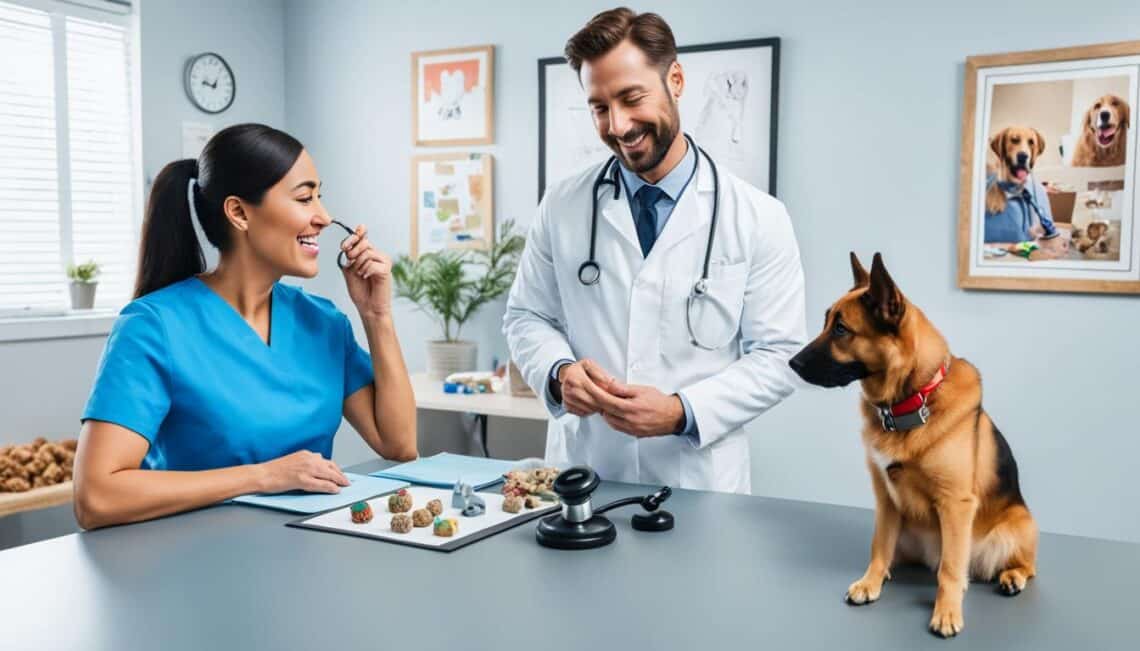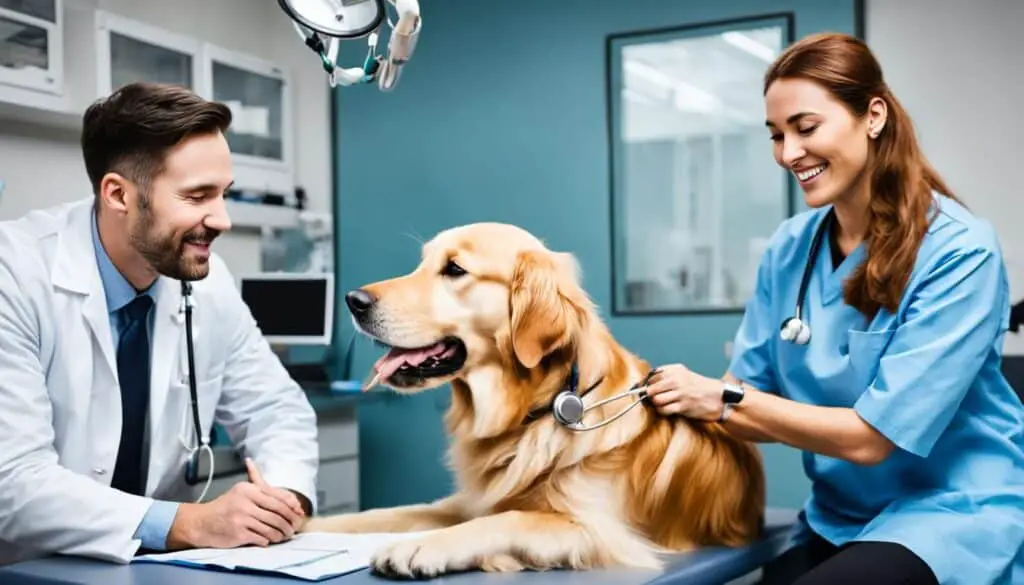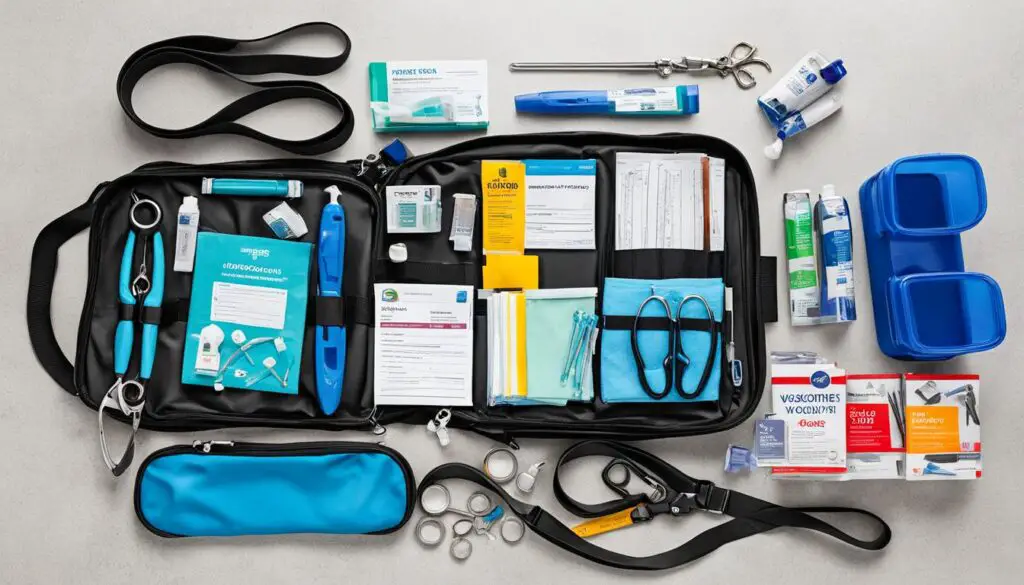Regular veterinary visits are essential for the health and wellness of your pet. However, these visits can often be stressful, especially for dogs. The unfamiliar environment, strange smells, and unfamiliar procedures can cause anxiety and fear in our furry friends. That’s why it’s important to take the necessary steps to prepare your pet and make their vet visit as calm and smooth as possible.
By following these tips and guidelines, you can help your pet feel more comfortable and relaxed during their vet visit:
Key Takeaways:
- Regular veterinary visits are important for your pet’s health and well-being.
- Dogs may experience anxiety during vet visits due to the unfamiliar environment and procedures.
- Handling exercises, such as massaging and touching your dog’s body, can help them become more comfortable with restraint and examination.
- Training exercises like teaching a standing position, nose targeting, and going to a designated place can make vet visits smoother.
- Taking your pet to the vet just for fun and providing positive experiences can change their association with the vet’s office.
With the right preparation, tools, and understanding of your pet’s behavior, you can help them have a stress-free vet visit and ensure their comfort and well-being. Remember, a little extra effort goes a long way in making the vet visit a positive experience for your beloved pet.
The Importance of Handling Exercises
One of the first steps in preparing your pet for a stress-free vet visit is to train them to accept restraint and examination. This can be done through handling exercises, such as massaging your dog and touching various parts of their body. By gradually increasing the level of handling and providing rewards and praise, your dog will learn to associate these interactions with positive experiences. This will help reduce their anxiety during vet visits.
Handling exercises are crucial in desensitizing your pet to touch, helping them become comfortable with being handled by the veterinarian. These exercises can include gentle touches, holds, and simulated procedures, such as checking their ears or trimming their nails. By getting your pet accustomed to these activities in a controlled and positive environment, you can help them feel more at ease during actual vet visits.
When starting handling exercises, it’s important to take it slow and be patient. Begin by touching your pet in areas they are comfortable with and gradually work your way towards more sensitive areas. Observe your pet’s body language and reaction during the exercises and adjust accordingly. If your pet shows signs of discomfort or anxiety, take a step back and reassess.
Taking the time to properly train your pet with handling exercises can make a significant difference in their overall stress levels during vet visits.
Remember to always reward your pet for their cooperation during handling exercises. Use treats, verbal praise, and gentle petting to reinforce positive behavior. This positive reinforcement will help your pet associate handling with positive experiences and create a sense of trust and comfort.
Additionally, it can be beneficial to involve other family members or friends in the handling exercises. This will help your pet become accustomed to being handled by different people, preparing them for interactions with the veterinary staff.
Benefits of Handling Exercises:
- Reduces pet anxiety during vet visits
- Builds trust and positive associations with being handled
- Helps desensitize pets to touch and procedures
- Improves overall veterinary experience for both pet and owner
By incorporating handling exercises into your pet’s routine, you can help make vet visits a more positive and less stressful experience for everyone involved. Remember, a well-prepared and confident pet is more likely to have a successful and anxiety-free trip to the vet.
| Before Handling Exercises | After Handling Exercises | |
|---|---|---|
| Physical signs of anxiety | Restless behavior, trembling, panting | Relaxed body language, decreased anxiety |
| Behavioral reactions | Avoidance, resistance, aggression | Cooperation, calmness, trust |
| Veterinary experience | Tense, stressful for pet and owner | Smooth, less stressful for pet and owner |
https://www.youtube.com/watch?v=itxLBM9455c
Training Can Help Smooth Vet Visits
In addition to handling exercises, there are other training exercises that can be helpful during vet visits. By teaching your dog specific behaviors, you can create a more comfortable and stress-free experience for both your pet and the veterinarian.
Teaching the Standing Position
One useful training exercise is teaching your dog to assume a standing position on command. This simple yet essential behavior allows the vet to examine your dog more easily, ensuring a thorough assessment of their overall health. To encourage your dog to stand, follow these steps:
- Start in a quiet and familiar environment. Use treats or positive reinforcement to entice your dog to stand. You can gently lift their front legs while giving the command “stand.”
- Gradually increase the duration of the standing position, rewarding your dog for maintaining the posture.
- Practice the standing position in various settings to help your dog generalize the behavior.
With consistent training, your dog will become comfortable with the standing position and be more cooperative during vet visits.
Training “Go to Your Place”
Another useful command to teach your pet is “go to your place.” This can be their mat, bed, or a designated spot where they feel safe and comfortable. Having a familiar space during a vet visit can provide reassurance to your pet and help them relax.
To train the “go to your place” command:
- Choose a specific location that will serve as your pet’s designated place.
- Guide your dog to that spot using a verbal cue, such as “go to your place.”
- Reward your dog with treats and praise when they go to their designated spot.
- Practice this command regularly, ensuring consistency and positive reinforcement.
By training your dog to go to their place, you can provide them with a sense of security and familiarity during vet visits.
Nose Targeting for Distraction
Nose targeting can be a useful tool to distract your dog during exams or uncomfortable procedures. By teaching your dog to touch their nose to a target, such as your hand or a small object, you can redirect their attention and help them stay calm.
To train nose targeting:
- Show your dog the target object and use a verbal cue, such as “touch.”
- Encourage your dog to touch the target with their nose by moving it closer to them or placing it on their hand.
- Reward your dog with treats and praise when they touch the target.
- Gradually increase the distance between your dog and the target, reinforcing the behavior as they continue to touch it.
Nose targeting can serve as a helpful distraction technique and shift your dog’s focus away from any stressful or uncomfortable procedures.
Training exercises such as teaching the standing position, “go to your place,” and nose targeting can help make vet visits smoother and less stressful for your pet. By investing time and effort into training, you can create a positive and comfortable experience for your furry friend during their visits to the vet.
Visiting the Vet Just for Fun
Many dogs associate vet visits with being examined or feeling sick, which can contribute to their anxiety.
To change this association and promote positive vet visits, one effective strategy is to take your dog to the vet just for fun. By arranging a short visit with your vet, your dog can experience a pleasant environment and receive treats and positive interactions. This helps them view the vet’s office as a place of positive experiences rather than stress.
Moreover, it’s important to ensure that car rides do not solely predict a trip to the vet. Taking your dog out to other places or drives can help familiarize them with car rides and reduce their stress during transportation to the clinic.
By creating opportunities for positive vet visits and familiarizing your dog with the vet’s office and car rides, you can help alleviate their anxiety and make the overall experience more enjoyable for both of you.
Taking the Right Tools to the Vet
When preparing for vet visits, it’s important to pack the right tools to ensure a smoother experience for your pet. By having the essentials on hand, you can help minimize stress and anxiety. Here are some key items to include in your pet’s vet visit kit:
- Favorite treats: Pack your pet’s favorite treats as a distraction during exams or uncomfortable procedures. Offering treats can help keep your pet focused and provide positive reinforcement throughout the visit.
- A toy: Bringing along your pet’s favorite toy can help divert their attention and provide comfort during the vet visit. Providing a familiar object can help reduce anxiety and create a sense of security for your pet.
- Pheromone treatments: For anxious dogs, consider using pheromone treatments such as Adaptil or Feliway. These products mimic natural pheromones to help calm and relax your pet during stressful situations. Consult with your vet to determine the most suitable option for your pet.
- Calming treats: Calming treats or supplements can also be beneficial for anxious pets. These products often contain ingredients such as chamomile, valerian root, or melatonin, which can help reduce stress and promote relaxation. Again, consult with your vet to find the best option for your pet’s specific needs.
Additionally, it can be helpful to schedule vet appointments during less busy times to minimize your pet’s stress. By avoiding crowded waiting rooms and long wait times, you can create a more relaxed environment for your pet.
Before the visit, discuss any specific needs or concerns with your vet. They can provide further guidance and recommendations based on your pet’s individual requirements. With the right tools and preparation, you can ensure the best possible experience for your pet during their vet visits.
Recognizing Signs of Stress in Pets
It’s important to be attentive to your pet’s behavior and recognize the signs of stress, as this can help you address their anxiety and make their vet visits more comfortable. Dogs and cats may display different signs of stress, so it’s crucial to understand their individual responses.
Here are some common signs of stress in dogs:
- Pacing
- Panting excessively
- Lip licking
- Vocalization (whining, barking)
On the other hand, cats may exhibit the following signs when stressed:
- Hiding
- Excessive grooming
- Vocalization (yowling, meowing)
By recognizing these signs, you can intervene early and take necessary steps to alleviate your pet’s anxiety. For example, if your dog starts pacing or panting at the vet’s office, you can implement calming techniques to help them relax.
“Being aware of your pet’s stress signals can significantly improve their experience at the vet’s office.” – Dr. Amanda Thompson
Remember that every pet is unique, and their stress responses may vary. By observing their behavior and understanding their individual signs of stress, you can tailor your approach to provide the necessary support and create a more positive experience for your furry friend.
Comparison of Stress Signs in Dogs and Cats
| Signs of Stress | Dogs | Cats |
|---|---|---|
| Pacing | ✓ | |
| Panting excessively | ✓ | |
| Lip licking | ✓ | |
| Vocalization (whining, barking) | ✓ | |
| Hiding | ✓ | |
| Excessive grooming | ✓ | |
| Vocalization (yowling, meowing) | ✓ |
Understanding the signs of stress in your pet allows you to take proactive measures to address their anxiety and create a more positive veterinary experience. With your careful attention and appropriate interventions, you can help your pet feel more at ease during vet visits and ensure their well-being.
Conclusion
Preparing your pet for vet visits is crucial for their well-being and can greatly reduce their stress and anxiety during these visits. By implementing handling exercises, training, and creating positive associations with the vet’s office, you can help your pet have a calmer and more comfortable experience.
Handling exercises, such as massaging your dog and gradually increasing the level of handling, can help them associate these interactions with positive experiences, reducing their anxiety at the vet. Additionally, training exercises like teaching your dog a standing position, going to their mat or bed, and nose targeting can further support their comfort during exams and procedures.
Creating positive associations with the vet’s office is also important. Taking your dog for short visits just for fun, where they receive treats and positive interactions, can help them view the vet’s office as a place of positive experiences. Additionally, ensuring car rides do not solely predict a vet visit by taking your dog out to other places or drives can reduce their stress during car rides to the clinic.
When preparing for vet visits, be sure to pack essential tools such as your pet’s favorite treats to distract them and a toy to divert their attention during uncomfortable procedures. Consider using pheromone treatments or calming treats for anxious dogs. And remember to schedule appointments during less busy times to minimize their stress. Lastly, be mindful of the signs of stress in your pet, such as pacing, panting, hiding, and excessive grooming, so you can address their anxiety and provide them with the best possible care.
FAQ
Why are regular veterinary visits important for my pet?
Regular veterinary visits are essential for the health and wellness of your pet. They allow the vet to monitor your pet’s overall health, detect any potential issues early on, and provide necessary preventive care.
Why do dogs get anxious during vet visits?
Dogs can experience anxiety during vet visits due to the unfamiliar environment and procedures. They may associate the vet’s office with being examined or feeling sick, which contributes to their stress.
How can handling exercises help reduce pet anxiety during vet visits?
Handling exercises, such as massaging your dog and touching various parts of their body, can train them to accept restraint and examination. By gradually increasing the level of handling and providing rewards and praise, your dog will associate these interactions with positive experiences, reducing their anxiety.
What training exercises can help make vet visits smoother?
Teaching your dog a standing position makes it easier for the vet to examine them. You can also train your dog to go to their mat or bed, providing them with a familiar and comforting space during the visit. Nose targeting can be used to distract your dog during exams or procedures.
How can I make vet visits a positive experience for my dog?
To change the association of vet visits with stress, you can take your dog to the vet just for fun. Ask your vet if you can bring your dog in for a short visit, where they can receive treats and positive interactions. This helps your dog view the vet’s office as a place of positive experiences.
What should I pack for a vet visit to reduce my pet’s stress?
Pack your pet’s favorite treats to distract them during exams and a toy to divert their attention during uncomfortable procedures. For anxious dogs, consider using pheromone treatments or calming treats. Schedule appointments during less busy times to minimize your pet’s stress.
How can I recognize signs of stress in my pet during vet visits?
Dogs may exhibit signs such as pacing, panting, lip licking, and vocalization, while cats may hide, groom excessively, or vocalize their stress. Being aware of these behaviors can help you address your pet’s anxiety and make their vet visits more comfortable.







No Comments